A REVIEW OF THE GRETSCH G9202 "HONEY DIPPER SPECIAL" RESONATOR GUITAR
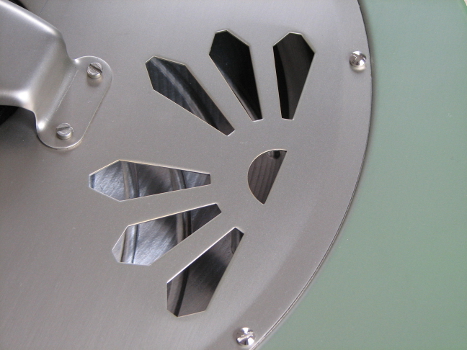 Click on pics for larger versions.
Click on pics for larger versions.
11/05/2014
GETTING THERE
My interest in the resonator guitar started with my first exposure to it back in the sixties via the Country & Western music that was popular in my home area in the 1960s. Then in the 1970s rock guitarists sought out this instrument and began integrating it into the Blues-oriented wing of Rock and Roll. Early on I fell in love with Duane Allman's miniature, "Little Martha," which I learned as a solo piece on acoustic guitar but always wanted to try on a resonator as it was originally played. Jeff "Skunk" Baxter played some really tasty reso with the Doobie Brothers beginning on their album, What Were Once Vices Are Now Habits... Through the years even I wrote fingerstyle pieces for the resonator, looking forward to the day when I might have access to one. Now, after a lull of a couple of decades, the resonator has become popular again. Movie and TV scores and even commercials feature the sound of this instrument warbling away in the background. The recent "Americana" musical movement with its love of alternate and rustic instruments is adding even more steam to the resurgence. And because of this resurgence we are seeing some really amazing and affordable modern instruments emerge onto the market, and that is what has moved my quest back onto the front burner.
This an age many believe is a new golden era of guitar construction. You can find practically any type of guitar you would ever want these days and many of the secrets of good guitar design have become open knowledge, available for use by everyone from high-end, small-shop builders to large-scale offshore manufacturers. It is into that environmental pool that we insert our toe to sample the waters of modern-day resonator guitars. Being a guy who does recording sessions and needs a handful of popular sounds, the increased demand for resonators made it feel like it was time to move. Of course for me, that signalled a need for research! Interestingly, most places I went for information only offered info about a couple of the resonator types but not all. At the beginning of my quest I combed all the sources I could find to get as much understanding of the issue as I could. Eventually I thought, "Why not let others benefit from my research?" And so once again my friends, off we go!
is a new golden era of guitar construction. You can find practically any type of guitar you would ever want these days and many of the secrets of good guitar design have become open knowledge, available for use by everyone from high-end, small-shop builders to large-scale offshore manufacturers. It is into that environmental pool that we insert our toe to sample the waters of modern-day resonator guitars. Being a guy who does recording sessions and needs a handful of popular sounds, the increased demand for resonators made it feel like it was time to move. Of course for me, that signalled a need for research! Interestingly, most places I went for information only offered info about a couple of the resonator types but not all. At the beginning of my quest I combed all the sources I could find to get as much understanding of the issue as I could. Eventually I thought, "Why not let others benefit from my research?" And so once again my friends, off we go!
HISTORY AND MECHANICS
In the 1920s innovator John Dopyera worked to create a guitar that had increased volume and ability to project in order to compete with the increasingly louder ensembles of the period. The result of his work was the first resonator, the "tricone," so-called because it creates sound by mechanically connecting its bridge to three small cones with a "T"-shaped bar. The bridge moves in response to the vibration of the strings and the cones vibrate like a speaker would, radiating the sound out the front of the guitar. Dopyera and George Beauchamp founded the National String Instrument Corporation. Their tricone guitars became popular in Hawaiian music but were very expensive. In order to cater to those who couldn't afford a tricone, National designed a less-expensive, single-cone resonator called the "biscuit bridge" design that has a round wooden "biscuit" sitting in the center of a single large cone that supports the bridge and is thus driven by the pressure and vibration of the strings. After Dopyera lost control of his patents though some bad business dealings, he left National and with his brothers formed the Dobro Corporation. There, he created another design known as the "spider bridge" resonator which features a bridge that is connected to a large inverted cone by a multi-legged device that looks like a, wait for it... spider. And there you have the three basic resonator designs that exist to this day: tricone, biscuit, and spider. The other basic differences between resonator guitars are neck type and body material. Square-neck guitars are designed to be played horizontally, lap style. Their strings are set high off the fingerboard and fretting isn't possible. Round-neck types have a regular, rounded neck and lower action so that they can be played "spanish" style, like a regular guitar, or lap style, laying down. Bodies can be wooden, brass, or steel and the choice of body material contributes an element to the sound of the instrument.
RESONATOR SOUNDS
Most people with experience say the key to a good, strong sound is the quality of the cone. Bad cone, bad sound. Good cone, good sound. You can't overcome a bad cone with good body construction or materials. Thus it is vitally important to the sound to have a well-engineered and constructed cone. Furthermore, each cone design produces a signature sound that must be factored into your choice of a resonator. The tricone has a balanced, mellow sound with the most gentle attack and loudest sustain of the bunch. The spider has a louder, more midrange-focused sound that lies in the middle as regards attack. The biscuit design is the loudest of the bunch and has the most focused midrange bark as well as a strong attack. Next you can factor in body types. Wooden bodies contribute a, wait for it, woodier, more mellow tone. Metal bodies contribute a metalic honk and a ring that resembles reverb. Between the metal body types, steel bodies contribute a more balanced sound and brass bodies contribute a stronger midrange and warmth. If we were to look at some of these tone factors on a continuum, it might look something like this:
BALANCED RESPONSE --------------------------- MIDRANGE BARK
COMPRESSION ------------------------------------------- ATTACK/LOUDNESS
First Consideration
Tricone Bridge -------------- Spider Bridge -------------- Biscuit Bridge
Second Consideration
Wood Body -------------- Steel Body -------------- Brass Body
"Gross over-generalization," you say, and you might just be right, but a simplification of this kind does help a beginner make some sense of the bewildering array of options in the resonator world. The cone quality and design make the biggest difference and probably should be your first considerations. Once you setle on a cone type you can adjust your tone to the right or left a bit by your choice of the two metal bodies or a wooden body. Once you've tried wooden bodies and metal bodies you can learn to identify which one supports the sound you are trying to achieve.
MY EXPERIENCE
Part of what brought me back into this quest was the appearance of Gretsch's Roots Series, offering many different body, neck and cone combos at an incredibly reasonable price point. As is usual for me I was chasing a sound in my head. That sound was the rootsy metalic sound used by the historic blues guys and by Duane Allman and Dickey Betts of the Allman Brothers. I wanted a round neck guitar to give me the flexibility to play fingerstyle, bottleneck, and lap style. It all started when my attention was directed to the rediculously inexpensive Gretsch Boxcar, a laminated mahogany guitar with a spider resonator. I was amazed with the quality of the fretwork and the smooth, full sound. I compared this guitar to those of a couple of other brands and it was clear that the Gretsch was loudest and prettiest of the bunch. Gretsch clearly have something going on with their cones! Were I only wanting to use the guitar for fingerstyle I might have chosen the Boxcar right there and considered myself lucky. But the Boxcar was missing something of the metalic ring and midrange honk that was banging around in my memory. At that point I resumed my research, looking at educational material, watching YouTube videos, asking questions on Internet forums, and checking out guitars. I learned about Duane Allman's choice of guitars. I began to zero in on the particular cone and body style that would be needed to create the sound in my my head. In the end it became clear that the sound I was chasing was created by a metal body and a biscuit cone.
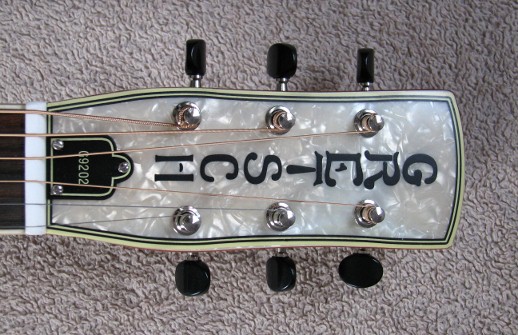 At the same time I began picking around in various stores where I was able to compare several different guitars. Looking at Gretsch's Roots line, I noticed that they've created a line of ten resonators by working from a component approach. They've created interchangeable cone suspensions, brass and steel bodies, bound and unbound wood bodies, bound and unbound necks, round necks, and square necks that can be assembled into various iterations of single-cone resonators. They have their cones hand-spun in Eastern Europe and assemble the guitars in China. As I identfied how the tone I was looking for was made, I began to home in on biscuit bridge designs. At a local dealer I found a couple of examples of Gretsch's Honey Dipper Special wth brass bodies and a Gretsch Alligator with a laminated mahogany body. The Alligator was a great guitar with plenty of volume and more of the midrange bark than the guitars I had previously auditioned but the Honey Dipper examples were considerably louder still and even more midrange-focused and seemed to take it a step further, right into the zone I wanted.
At the same time I began picking around in various stores where I was able to compare several different guitars. Looking at Gretsch's Roots line, I noticed that they've created a line of ten resonators by working from a component approach. They've created interchangeable cone suspensions, brass and steel bodies, bound and unbound wood bodies, bound and unbound necks, round necks, and square necks that can be assembled into various iterations of single-cone resonators. They have their cones hand-spun in Eastern Europe and assemble the guitars in China. As I identfied how the tone I was looking for was made, I began to home in on biscuit bridge designs. At a local dealer I found a couple of examples of Gretsch's Honey Dipper Special wth brass bodies and a Gretsch Alligator with a laminated mahogany body. The Alligator was a great guitar with plenty of volume and more of the midrange bark than the guitars I had previously auditioned but the Honey Dipper examples were considerably louder still and even more midrange-focused and seemed to take it a step further, right into the zone I wanted.
As I auditioned the candidates one of the things I soon noticed was that a resonator guitar sounds VERY different at the player's position from the way it sounds at the listener's position. You get a more "stringy" sound and an overall thinner presentation at the player's position than you get out front. So, to help me evaluate the different guitars, I brought in my wife with her trained ears to sit across from me and listen. I also played the guitars flat on my lap with an ergo slide to get a feeling for their sound with them facing me and I took the guitars into quiet audition rooms to get away from the wallah and clamor of the guitar stores. There's nothing quite like '80s hair band music in your ears while you are trying out a reso. After a few hours of listening, my wife and I agreed that the brass-bodied guitars had a sweeter, fuller sound that matched my playing style and uses. The brass-bodied, biscuit bridge choices from Gretsch are the G9201 that has a nickel-plated brass body with an unbound neck, and the G9202 "special edition" with natty "Swamp Green" or "Desert Flower" (pink) painted brass bodies and bound necks. My family has a history of skin chemistry that interacts with nickel so I steered away from the nickel-plated version and towards the painted versions. After hours of comparing the examples in our area we fell in love with the sound of a particular Swamp Green guitar at my dealer because it was a bit fuller sounding than the Desert Flower example. From there it was down to negotiating a deal and bringing it home. These guitars are advertised all over the Internet at a price point reflecting 40% of MSRP and there isn't a lot of markup for the retailer so don't expect a lot of room for them to move. Interestingly, none of the dealers I visited had the Gretsch reso cases in stock, so I had to take in the case from my classical guitar to bring the guitar home. Surprise! That case fit pretty well. I ordered the Gretsch case soon after I got the guitar home.
Once I had the instrument home and could experiment with it I was amazed how quickly new music began coming out. Firstly, I had never really separated out Dickey Betts' acoustic parts from "Little Martha" when I learned the song as a solo in the '70s. I had puttered a little but the tonality of Dickey's flattop was sort of drowned out by Duanes resonator when I first heard it on cheap gear in the '70s. Within a short time with the Gretsch reso in my hands it became clear what Dickey's parts were... they just seemed to "fall out" into my lap. It's amazing what having the right timbre producer in your hands can do... at least for me. Also, fourteen years ago on our twentieth anniversary I composed a song for reso for my wife. Of course I didn't own a reso, so I wasn't able to play it for her on the right guitar until the Honey Dipper came home. I had expected that this instrument would be too loud to be a good couch instrument - that the volume would make it hard for my wife to hear the TV. In practice I found that the brass body and biscuit cone indeed may contribute more midrange and loudness but the combo also offer plenty of dynamic response as well. When played lightly the guitar can be quite delicate. Through my experienced when looking at electric lap steel guitars I found that some combinations of components emphasize bar chatter from a slide and others de-emphasize it. In this case, when looking at resonators, the brass body and biscuit cone Gretsch guitars seem to de-emphasize the slide chatter in a way that I prefer even with louder brass slides. And, oh, yeah: The little "Reverb.com" clip-on tuners don't work too well on this guitar.
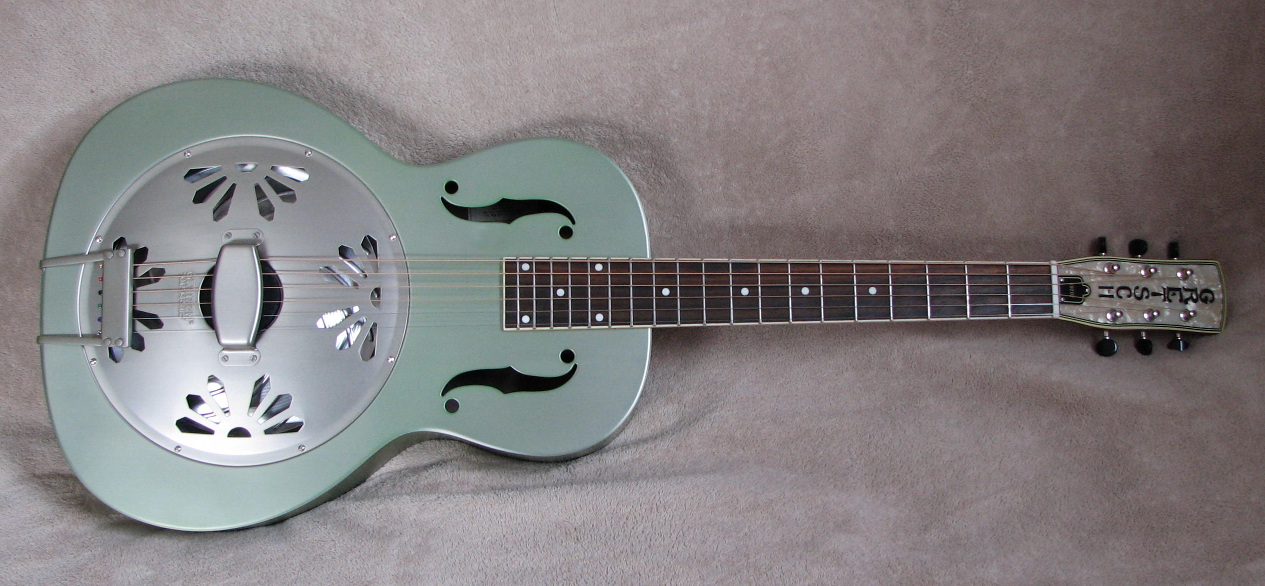
IN THE BALANCE
So, how about something like an objective evaluation? The fit and finish on the Gretsches I tried were top-notch. The paint is a semi-gloss that doesn't make noise when you move against it. The hardware is "weathered" to look comfy. The ergnomics are good. As with all resonators, the weight centerpoint is near the center of the resonator which is back at the bridge. Looking into the f-hole with a flashlight you can see the center block that bears the stress between the neck, resonator, and tailpiece, and you can see the back-support pillar as well. Everything seems cleanly-built. When seated on a chair I found it most comfortable to rest the guitar on the left knee and pull my right leg up snug in classical style, like you do with a Les Paul electric, but it really loves to be played when you are seated comfortably on a couch. At ten pounds this guitar isn't a lightweight. The overall impression is of a sturdy, solid, serious instrument.
It is especially important to me that a guitar have good a good neck, consistent fretwork, and tall enough frets to make me comfortable. This neck offers all that. The gentle V-profile provides plenty of support without becoming a handful. I've played the guitar for two hours or more without left-hand muscle fatigue. The nut width is 1.75" but the shoulders are fairly narrow. The medium jumbo frets are tall enough and are well-finished. How about action? Since the guitar is a dual-purpose instrument (fingerstyle and bottleneck) it has a compromise action, higher than I am used to. It has to be that way to support both slide and fingerstyle. However, that means I have to work a little harder than I am used to in order to play the instrument, specifically on hammer-ons. Get used to it. It is not recommended that you lower the action on a resonator because it needs the break angle generated by the bridge height to drive the cone. Also, having spent several years on Taylor guitars which have probably the very best intonation on the planet, I've noticed that the intonation isn't perfect. It is quite good, but not perfect. Perhaps a luthier or a good tech could figure out how to replace the ebony bridge tip with a compensated one. But we are talking about an amazingly inexpensive instrument with a fixed bridge.
And here is the big surprise delivered by the instrument: I was ready for this guitar to not have a lot of sustain because general Internet opinion held that the brass-bodied resos were lowest in the sustain 'food chain.' However, it seems to me that the brass/biscuit instrument has plenty of attack AND a lot of sustain. Now, if you really lay into the instrument, the attack is loud enough that the sustain phase is quite a bit lower in volume than the attack, something like a Stratocaster electric guitar. But I've been interested to find that when the instrument is played quietly, a combination of the sustain and the "ring" or "reverb" makes fingerstyle pieces hold together rather nicely. Pieces that seemed to lack cohesion on some regular flattop acoustics feel glued together much better on the reso and don't have that feeling that the world is coming to a full stop between notes.
CONCLUSIONS
So here is where I reveal my final impression: This is a great-playing, robust, wonderful-sounding guitar that would be as much at home as an entry level or auxilary instrument as it would as a professional road warrior. There are pros using these guitars on the road even as I write. They are that good. I'm just amazed at the quality of the instruments that have come to market in recent years. Specifically in this case, I've found the quality of the Gretsch Roots Series Resonators to be high and uniform. The Honey Dipper Special is a great sounding and playing instrument, and the extremely reasonable prices simply make the experience that much sweeter!

THE SPECS
Gretsch Roots Series G9202 Honey Dipper Special Resonator Guitar
Bell brass body
Swamp Green finish
Weathered hardware
Dimensions: depth 3.5", upper bout width 9.875", lower bout width 14.125"
99% pure hand-spun aluminum "Amplisonic" cone
Maple biscuit with ebony bridge cap
Mahogany, medium V shaped neck with semi-gloss finish and honey mahogany stain
25" scale
1.75" bone nut
Rosewood fingerboard with aged binding
19 medium-jumbo frets, 12 to body
Grover Sta-Tite Tuners with black buttons
Mother of Pearl headstock overlay and position markers
D'Addario® EJ16 phosphor bronze, light strings (.012-.053 Gauges)
Available Accessories: Gig Bag G2180, Hard Case G6296
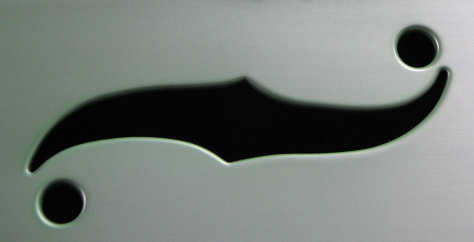
MAKING THE CASE
A word about the Gretsch G6296 hardshell case: I feel like my guitars need a hard case so that I can protect them when I'm moving them and can maintain their humidity during the winter, so I ordered the Gretsch case a few days after I purchased the guitar. These cases are built for Gretsch by TKL Products Corp. TLK specializes in "just-in-time" case supply to guitar manufacturers such as Gibson and Gretsch, among others. The official Gretsch website description of the case is a near-verbatim lift from the description offered by TLK for their Premier (mid-grade) case line, right down to the TKL-trademarked component names. Best I can tell, this is a TKL Premier case, custom-built to the guitar's dimensions with the lining color changed from the stock silver-gray to a very, very lurid purple and the attractive brass TLK nameplate exchanged for an equally-attractive brass Gretsch nameplate. The feature set includes three large, heavy-duty draw-tight latches the middle of which has a lock hasp, three bottom feet, four standing feet, three hinges, and a cloth tab at the bottom of the case to hold the lid open. It is a solid, sturdy, well-built case with heavy-duty hardware, a comfortable handle, a single-point neck support, and a flat lid. An arched lid would be stronger and a two-point neck support would be welcome but they would push this case into a higher price bracket, which might be hard to justify for a guitar this inexpensive.
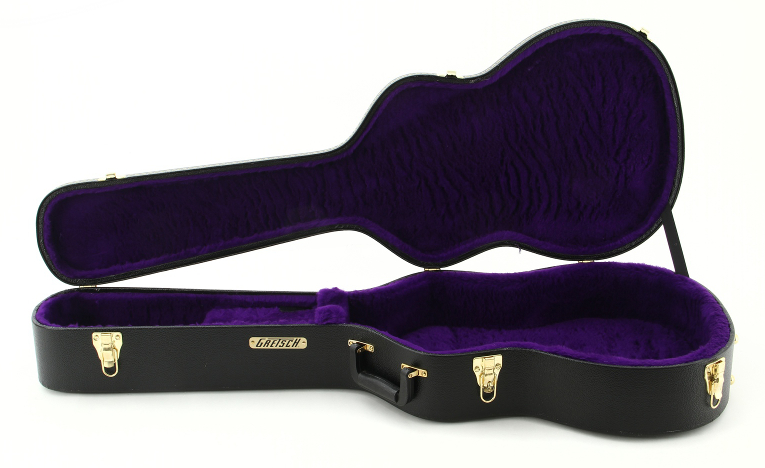
I read through the shipping labels on the box and discovered a huge irony: First, the case was built by a company headquartered in Oilville, VA, two hours away from me, but it was built up at their plant in Montreal, Canada. I bought it from Amazon in Washington State who got it from a wholesaler near Nashville, Tennessee. To reach me it either traveled 7,177 miles if it went directly via TKL headquarters or 11,146 miles if it first went through Fender/Gretsch. That's either two or three horizontal, transcontinental trips and one vertical, near-transcontinental trip. Of course, the guitar traveled at least 11,380 miles to get to me...
Case specs: Multi-Ply, Hand-Laminated Wood Shell, Heavy-Duty Durahyde™ Covering, Providence Forge® Steel-Plated Hardware, Comfort Grip™ Molded Handle, Softly Padded Purple Plush Interior, Spacious Accessory Compartment, Traditional Neck Support System™.
Gretsch G9202 Page
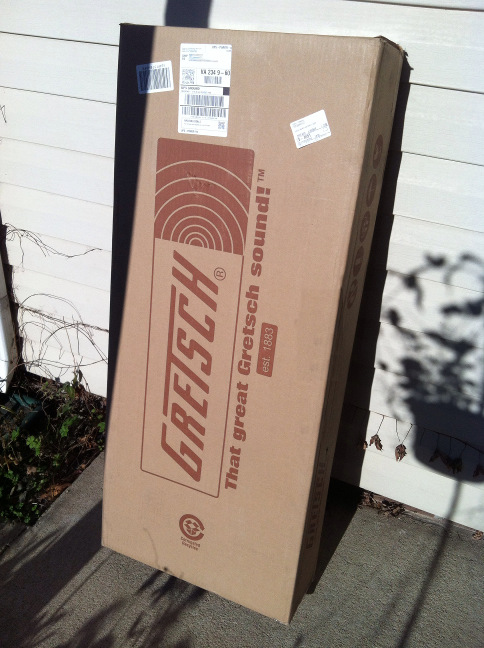
UPDATE: Within weeks of purchasing the guitar I had a scoring session that needed it. HERE is a sample from that session.
UPDATE TWO: 12/28/2016
A couple of weeks ago I pulled out the Gretsch to work up some Christmas carols. After I played a few notes I noticed that the bass strings went "plonk, plonk, plonk." While inspectng the bridge area I realized that the bass side of the biscuit and bridge had sunk below the treble side. Further examination revealed that the resonator cone had collapsed on that side. I took the guitar back to my dealer for repairs. A call to Gretsch revealed that they considered the cone to be "hardware," not covered by the lifetime instrument warranty but instead by the now-expired one year "hardware" warranty. Um, that makes you wonder, "On a metal guitar, just exactly what isn't considered hardware?" Furthermore, Gretsch do not offer replacement resonator cones. SURPRISE!!! So, I ordered a Beard replacement cone from Stewart-MacDonald Luthier's Supply ($60) and it was promptly delivered. My nice dealer, Alpha Music in Virginia Beach, VA, will be fitting it up for me shortly. I'll report back when the situation is resolved.
UPDATE THREE: 01/03/2017
Today the guitar came home from the shop. Alpha Music's instrument technician, Walter, did a fine job replacing the original cone with the Beard cone and setting up the action after the replacement. The guitar sounds louder and brighter and sustains longer than it did with the original cone. Voile'! Hopefully this is the end of the casualty. I had been parking the guitar in Open E, which requires tuning three strings upwards from standard tuning. I think I'll park it in Open D, basically the same tuning as Open E but a step lower. Open D requires tuning DOWN three strings, which should stress the cone less. Thanks to everyone at Apha!
And the fate of the old cone? I was intrigued with the look of the spiral reinforcements from the first time I peeked at it through the grille. It was too fascinating to just dump. I asked Walter to save it for me and it is now a great steampunk decoration at the studio, hanging near my mixing position. Oh, I should say RARE steampunk art. Since Gretsch no longer offers them, you can only get one by buying the guitar.
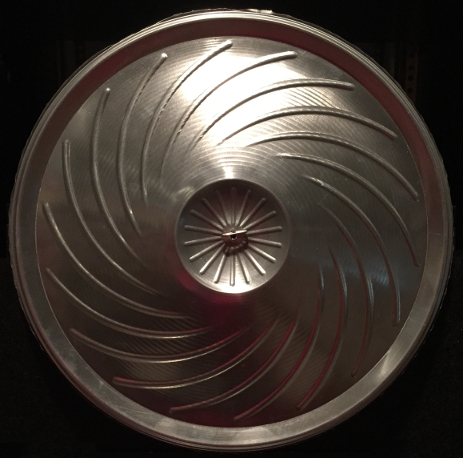
= =
=

 is a new golden era of guitar construction. You can find practically any type of guitar you would ever want these days and many of the secrets of good guitar design have become open knowledge, available for use by everyone from high-end, small-shop builders to large-scale offshore manufacturers. It is into that environmental pool that we insert our toe to sample the waters of modern-day resonator guitars. Being a guy who does recording sessions and needs a handful of popular sounds, the increased demand for resonators made it feel like it was time to move. Of course for me, that signalled a need for research! Interestingly, most places I went for information only offered info about a couple of the resonator types but not all. At the beginning of my quest I combed all the sources I could find to get as much understanding of the issue as I could. Eventually I thought, "Why not let others benefit from my research?" And so once again my friends, off we go!
is a new golden era of guitar construction. You can find practically any type of guitar you would ever want these days and many of the secrets of good guitar design have become open knowledge, available for use by everyone from high-end, small-shop builders to large-scale offshore manufacturers. It is into that environmental pool that we insert our toe to sample the waters of modern-day resonator guitars. Being a guy who does recording sessions and needs a handful of popular sounds, the increased demand for resonators made it feel like it was time to move. Of course for me, that signalled a need for research! Interestingly, most places I went for information only offered info about a couple of the resonator types but not all. At the beginning of my quest I combed all the sources I could find to get as much understanding of the issue as I could. Eventually I thought, "Why not let others benefit from my research?" And so once again my friends, off we go! At the same time I began picking around in various stores where I was able to compare several different guitars. Looking at Gretsch's Roots line, I noticed that they've created a line of ten resonators by working from a component approach. They've created interchangeable cone suspensions, brass and steel bodies, bound and unbound wood bodies, bound and unbound necks, round necks, and square necks that can be assembled into various iterations of single-cone resonators. They have their cones hand-spun in Eastern Europe and assemble the guitars in China. As I identfied how the tone I was looking for was made, I began to home in on biscuit bridge designs. At a local dealer I found a couple of examples of Gretsch's Honey Dipper Special wth brass bodies and a Gretsch Alligator with a laminated mahogany body. The Alligator was a great guitar with plenty of volume and more of the midrange bark than the guitars I had previously auditioned but the Honey Dipper examples were considerably louder still and even more midrange-focused and seemed to take it a step further, right into the zone I wanted.
At the same time I began picking around in various stores where I was able to compare several different guitars. Looking at Gretsch's Roots line, I noticed that they've created a line of ten resonators by working from a component approach. They've created interchangeable cone suspensions, brass and steel bodies, bound and unbound wood bodies, bound and unbound necks, round necks, and square necks that can be assembled into various iterations of single-cone resonators. They have their cones hand-spun in Eastern Europe and assemble the guitars in China. As I identfied how the tone I was looking for was made, I began to home in on biscuit bridge designs. At a local dealer I found a couple of examples of Gretsch's Honey Dipper Special wth brass bodies and a Gretsch Alligator with a laminated mahogany body. The Alligator was a great guitar with plenty of volume and more of the midrange bark than the guitars I had previously auditioned but the Honey Dipper examples were considerably louder still and even more midrange-focused and seemed to take it a step further, right into the zone I wanted.




